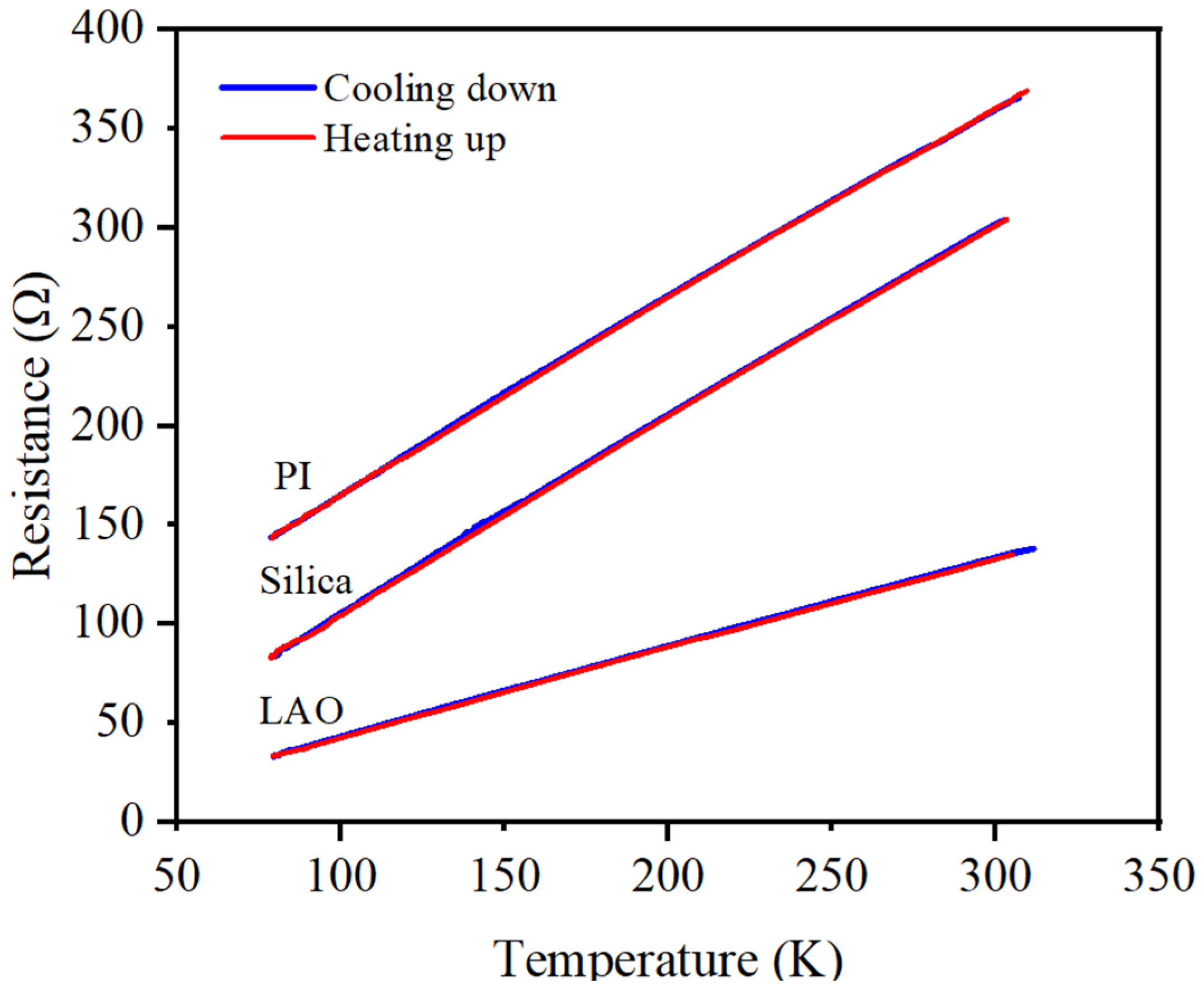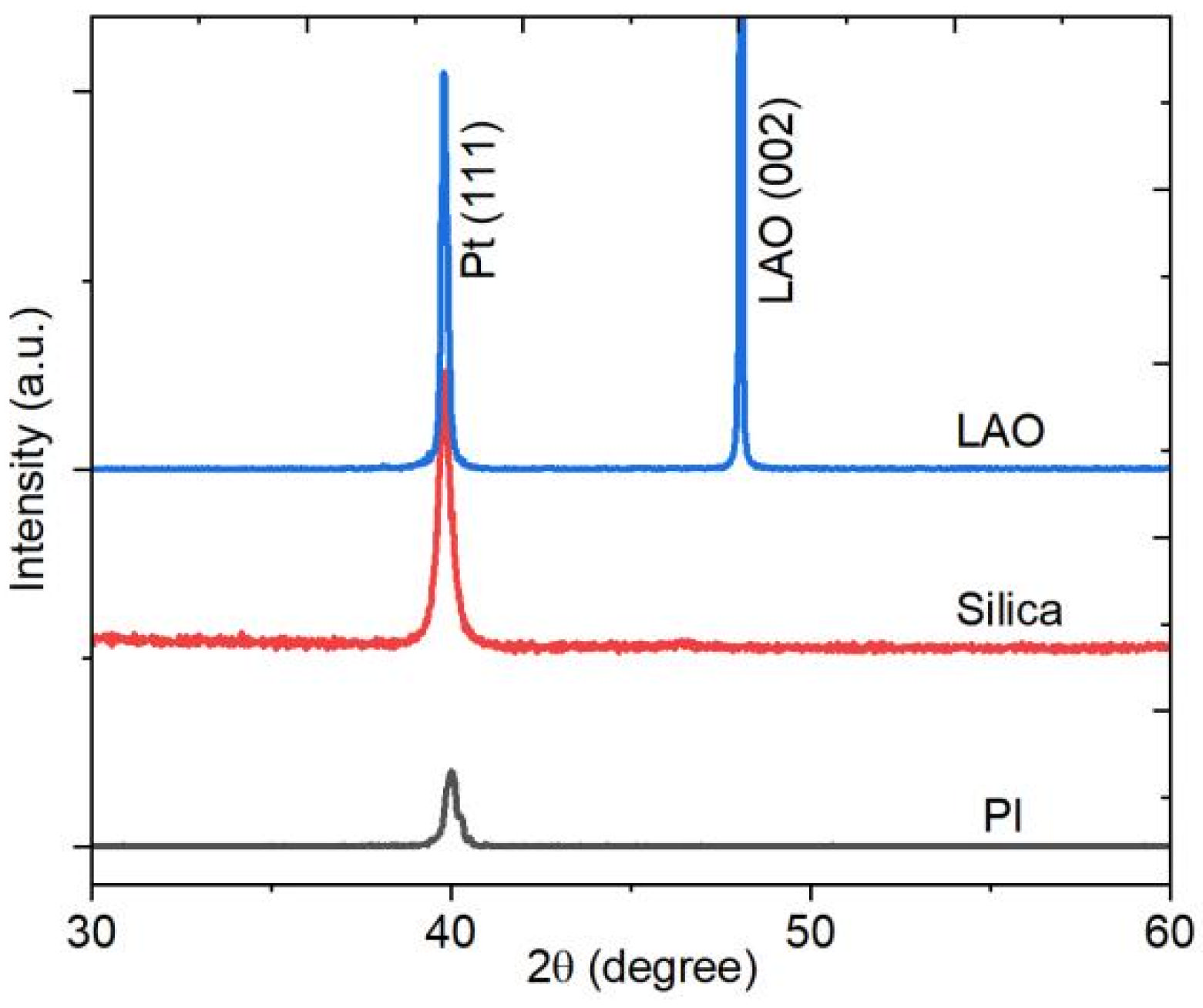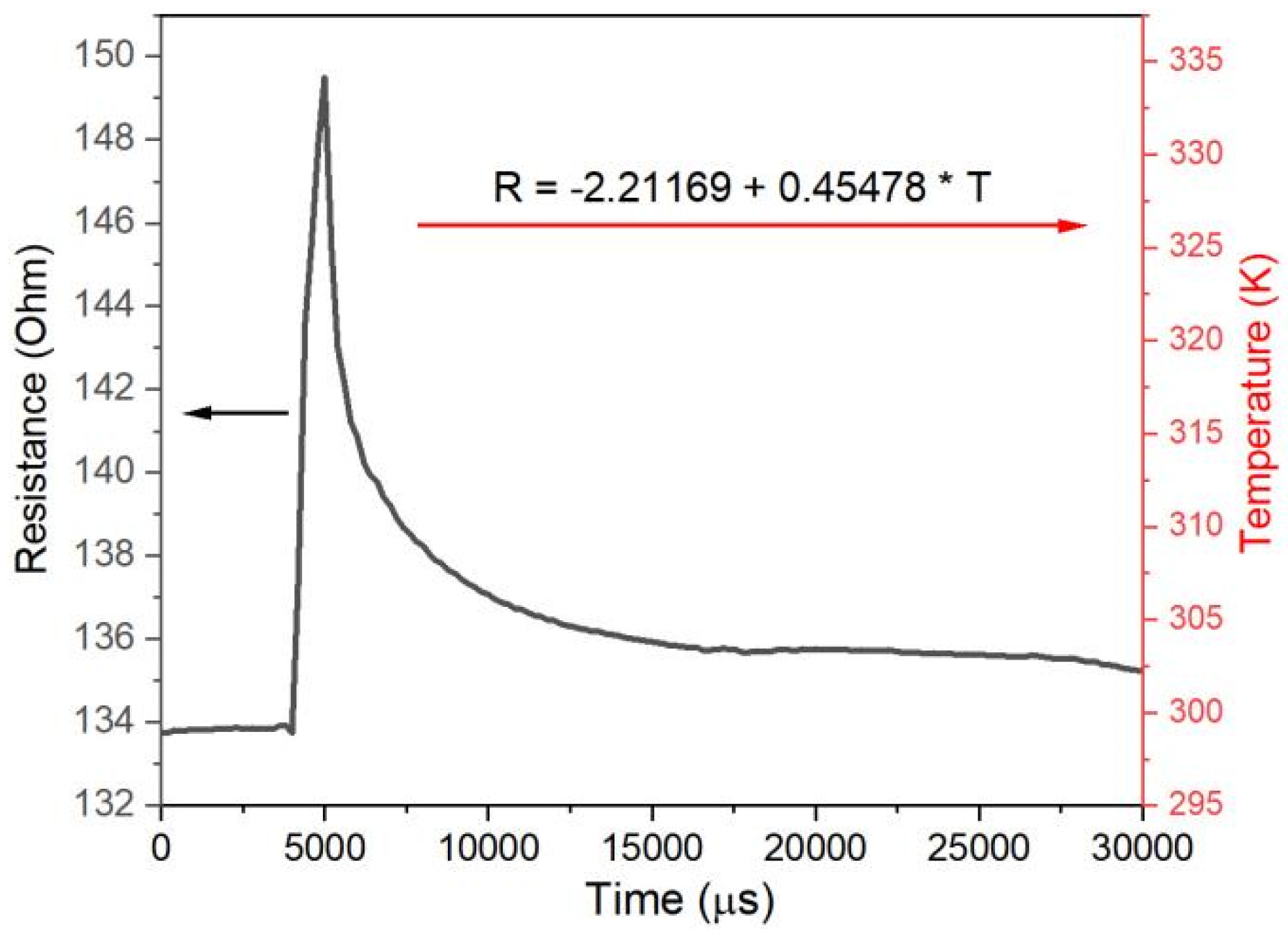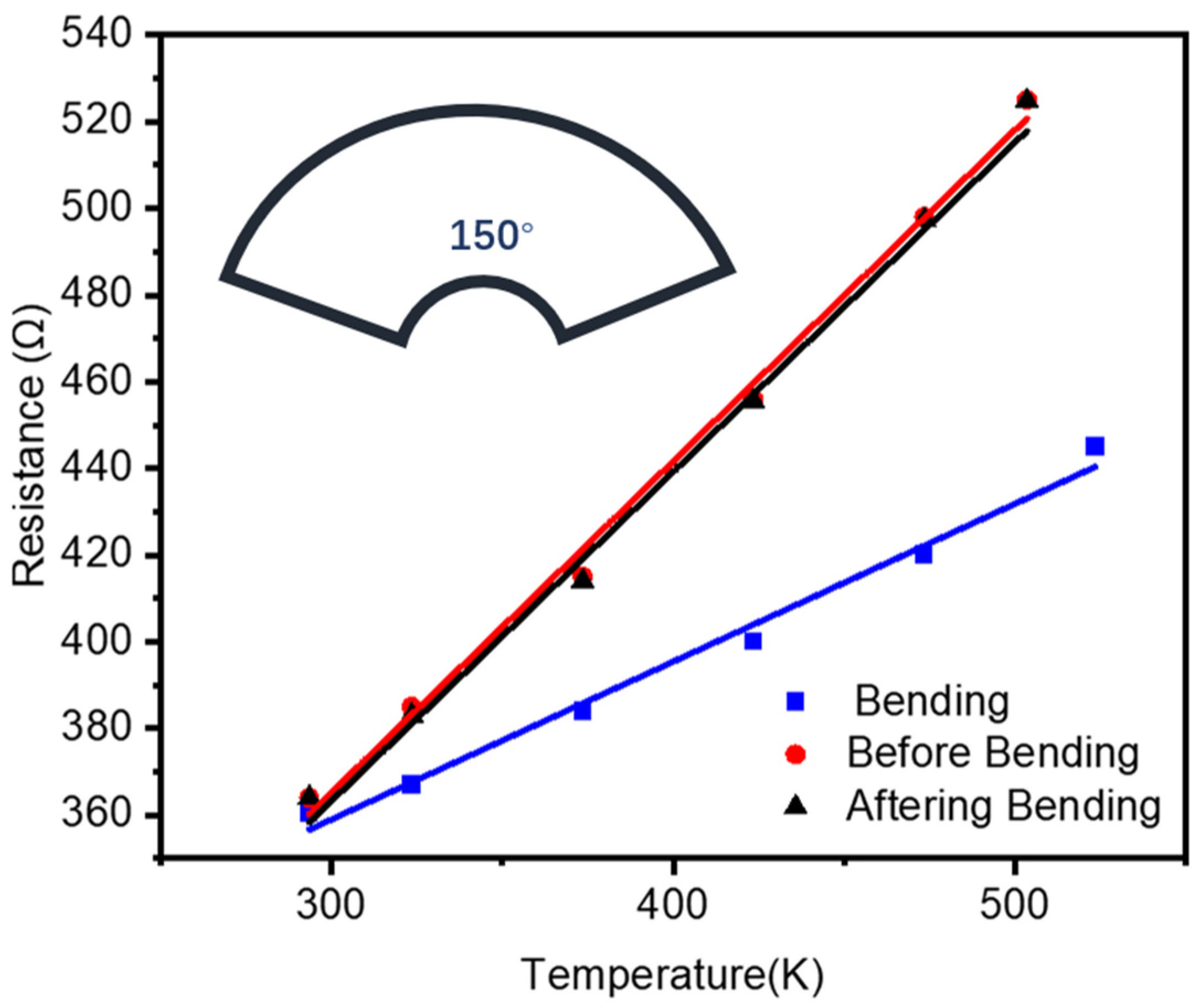Effects of Substrates on the Performance of Pt Thin-Film Resistance Temperature Detectors
Abstract
:1. Introduction
2. Experimental Details
3. Results and Discussion
4. Conclusions
Author Contributions
Funding
Institutional Review Board Statement
Informed Consent Statement
Data Availability Statement
Conflicts of Interest
References
- D’Aleo, F.P.; Stalder, R.; Prasser, H.-M. Design and development of resistive temperature detector arrays on aluminium substrates. Measurements in mixing experiments. Flow Meas. Instrum. 2015, 45, 176–187. [Google Scholar] [CrossRef]
- Shao, L.; Zhao, X.; Gu, S.; Ma, Y.; Liu, Y.; Deng, X.; Jiang, H.; Zhang, W. Pt thin-film resistance temperature detector on flexible Hastelloy tapes. Vacuum 2021, 184, 109966. [Google Scholar] [CrossRef]
- Kim, J.; Kim, J.; Shin, Y.; Yoon, Y. A study on the fabrication of an RTD (resistance temperature detector) by using Pt thin film. Korean J. Chem. Eng. 2001, 18, 61–66. [Google Scholar] [CrossRef]
- Shen, A.; Kim, S.B.; Bailey, C.; Ma, A.W.; Dardona, S. Direct write fabrication of platinum-based thick-film resistive temperature detectors. IEEE Sens. J. 2018, 18, 9105–9111. [Google Scholar] [CrossRef]
- Tiggelaar, R.M.; Sanders, R.G.P.; Groenland, A.W.; Gardeniers, J.G.E. Stability of thin platinum films implemented in high-temperature microdevices. Sens. Actuators A Phys. 2009, 152, 39–47. [Google Scholar] [CrossRef]
- Moser, Y.; Gijs, M.A.M. Miniaturized flexible temperature sensor. J. Microelectromech. Syst. 2007, 16, 1349–1354. [Google Scholar] [CrossRef]
- Lee, C.Y.; Lee, G.B. Micromachine-based humidity sensors with integrated temperature sensors for signal drift compensation. J. Micromech. Microeng. 2003, 13, 620–627. [Google Scholar] [CrossRef]
- Oh, C.; Stovall, C.B.; Dhaouadi, W.; Carpick, R.W.; de Boer, M.P. The strong effect on MEMS switch reliability of film deposition conditions and electrode geometry. Microelectron. Reliab. 2019, 98, 131–143. [Google Scholar] [CrossRef]
- Zribi, A.; Barthès, M.; Bégot, S.; Lanzetta, F.; Rauch, J.Y.; Moutarlier, V. Design, fabrication and characterization of thin film resistances for heat flux sensing application. Sens. Actuators A Phys. 2016, 245, 26–39. [Google Scholar] [CrossRef]
- Zeng, Y.; Chen, G.; Zhao, F.; Wu, C.; Xu, L.; Zhang, Y.; Wu, W.; Lin, Y.; He, G.; Chen, Q. Metal-based sandwich type thick-film platinum resistance temperature detector for in-situ temperature monitoring of hot-end components. Appl. Surf. Sci. 2023, 637, 157979. [Google Scholar] [CrossRef]
- Lv, W.; Wang, Y.; Shi, W.; Cheng, W.; Huang, R.; Zhong, R.; Zeng, Z.; Fan, Y.; Zhang, B. Role of micro-nano fabrication process on the temperature coefficient of resistance of platinum thin films resistance temperature detector. Mater. Lett. 2022, 309, 131313. [Google Scholar] [CrossRef]
- Han, J.; Cheng, P.; Wang, H.; Zhang, C.; Zhang, J.; Wang, Y.; Duan, L.; Ding, G. MEMS-based Pt film temperature sensor on an alumina substrate. Mater. Lett. 2014, 125, 224–226. [Google Scholar] [CrossRef]
- Resnik, D.; Kovač, J.; Vrtačnik, D.; Godec, M.; Pečar, B.; Možek, M. Microstructural and electrical properties of heat treated resistive Ti/Pt thin layers. Thin Solid Films. 2017, 639, 64–72. [Google Scholar] [CrossRef]
- Mailly, F.; Giani, A.; Bonnot, R.; Temple-Boyer, P.; Pascal-Delannoy, F.; Foucaran, A.; Boyer, A. Anemometer with hot platinum thin film. Sens. Actuators A Phys. 2001, 94, 32–38. [Google Scholar] [CrossRef]
- Jiao, R.; Wang, K.; Xin, Y.; Sun, H.; Gong, J.; Yu, L.; Wang, Y. Enhancing the temperature coefficient of resistance of Pt thin film resistance-temperature-detector by short-time annealing. Ceram. Int. 2023, 49, 12596–12603. [Google Scholar] [CrossRef]
- Grosser, M.; Schmid, U. The impact of annealing temperature and time on the electrical performance of Ti/Pt thin films. Appl. Surf. Sci. 2010, 256, 4564–4569. [Google Scholar] [CrossRef]
- Çiftyürek, E.; Sabolsky, K.; Sabolsky, E.M. Platinum thin film electrodes for high-temperature chemical sensor applications. Sens. Actuators B Chem. 2013, 181, 702–714. [Google Scholar] [CrossRef]
- Weng, S.; Qiao, L.; Wang, P. Thermal stability of Pt-Ti bilayer films annealing in vacuum and ambient atmosphere. Appl. Surf. Sci. 2018, 444, 721–728. [Google Scholar] [CrossRef]
- Kim, N.H.; Na, D.M.; Ko, P.J.; Park, J.S.; Lee, W.S. Electrical and thermal properties of platinum thin films prepared by DC magnetron sputtering for Micro-Heater of microsensor applications after CMP process. Solid State Phenomena 2007, 124, 267–270. [Google Scholar] [CrossRef]
- Schössler, T.; Schön, F.; Lemier, C.; Urban, G. Effect of high temperature annealing on resistivity and temperature coefficient of resistance of sputtered platinum thin films of SiO2/Pt/SiOx interfaces. Thin Solid Films 2020, 698, 137877. [Google Scholar] [CrossRef]
- Bernhardt, G.; Silvestre, C.; LeCursi, N.; Moulzolf, S.C.; Frankel, D.J.; Lad, R.J. Performance of Zr and Ti adhesion layers for bonding of platinum metallization to sapphire substrates. Sens. Actuators B Chem. 2001, 77, 368–374. [Google Scholar] [CrossRef]
- Fricke, S.; Friedberger, A.; Seidel, H.; Schmid, U. A robust pressure sensor for harsh environmental applications. Sens. Actuators A Phys. 2012, 184, 16–21. [Google Scholar] [CrossRef]
- Chen, W.; Wang, P.; Cui, Q.; Qiang, Z.; Qiao, L.; Li, Q. Effect of titanium adhesion layer on the thermal stability of platinum films during vacuum high temperature treatment. Vacuum 2024, 226, 113295. [Google Scholar] [CrossRef]
- Lin, X.; Zhang, C.; Yang, S.; Guo, W.; Zhang, Y.; Yang, Z.; Ding, G. The impact of thermal annealing on the temperature dependent resistance behavior of Pt thin films sputtered on Si and Al2O3 substrates. Thin Solid Films 2019, 685, 372–378. [Google Scholar] [CrossRef]
- Zhang, F.; Wang, F.; Gu, N. A non-invasive and high precision sensor for in-situ temperature monitoring of cells. J. Micromech. Microeng. 2022, 32, 095001. [Google Scholar] [CrossRef]
- Manoj, K.; Vijay, S.; Jaspreet, S.; Ashok, S.B.; Alok, J.; Singh, A.S.P.; Surinder, S. Experimental study of chromium oxide thin films as an intermediate layer for Pt-based temperature sensor applications. J. Mater. Sci. Mater. Electron. 2022, 33, 21287–21296. [Google Scholar]
- Zhao, X.; Gao, W.; Yin, J.; Fan, W.; Wang, Z.; Hu, K.; Mai, Y.; Luan, A.; Xu, B.; Jin, Q. A high-precision thermometry microfluidic chip for real-time monitoring of the physiological process of live tumour cells. Talanta 2021, 226, 122101. [Google Scholar] [CrossRef] [PubMed]
- Kim, D.S.; Choi, K.S.; Yang, H.J.; Ryu, M.S.; Chae, J.S.; Chang, S.P. Optimizing the response time of Ni-based resistive temperature detectors. J. Micro/Nanolithogr. MEMS MOEMS 2015, 14, 025002. [Google Scholar] [CrossRef]
- Seungwon, K.; Soomook, L.; Hee, J.M.; Wonjoon, K.; Seunghyun, B.; Won, S.J. Flexible thermocouple using a thermoelectric graphene fiber with a seamless junction. J. Mater. Sci. Technol. 2024, 172, 15–22. [Google Scholar]
- Zeng, Q.; Sun, B.; Xu, J.; Deng, X.; Xu, J.; Jia, Y. Development of NiCr/NiSi Thin-Film Thermocouple Sensor for Workpiece Temperature Measurement in Chemical Explosive Material Machining. J. Manuf. Sci. Eng. 2006, 128, 175–179. [Google Scholar] [CrossRef]
- Juyeon, K.; Dinh, D.H.; Il, R.J. Preparation and characterization of electrospun fluorescent fiber mats as temperature sensors using various polymers. Polym. Test. 2023, 122, 108019. [Google Scholar]
- Sanjay, P.S.; Shrutidhara, S. High-performance flexible temperature sensor from hybrid nanocomposite for continuous human body temperature monitoring. Polym. Compos. 2022, 44, 1381–1391. [Google Scholar]
- Liu, Z.; Tian, B.; Jiang, Z.; Li, S.; Lei, J.; Zhang, Z.; Liu, J.; Shi, P.; Lin, Q. Flexible temperature sensor with high sensitivity ranging from liquid nitrogen temperature to 1200 °C. Int. J. Extrem. Manuf. 2023, 5, 015601. [Google Scholar] [CrossRef]






| Substrates of RTDs | TCR(10−3/K) | Reference |
|---|---|---|
| Alumina | 2.400 | [12] |
| Si/SiO2/Si4N3/ SiO2 | 2.810 | [20] |
| Si and Al2O3 ceramics | <3.200 | [24] |
| Flexible hastelloy tapes | 2.790 | [2] |
| Glass (b270) | 2.800 | [25] |
| Silicon | 2.885 | [26] |
| Glass | 2.090 | [27] |
| Polyimide (PI) | 2.700 | This work |
| Silica | 3.200 | This work |
| LaAlO3 single crystal | 3.400 | This work |
| Substrates of Pt Thin Film RTD | Silica | PI | LAO |
|---|---|---|---|
| Resistance at 80 K (Ω) | 83 | 143 | 33 |
| Slope (Ω/K) | 0.99 | 0.98 | 0.45 |
| TCR (10−3/K) | 3.2 | 2.7 | 3.4 |
| Materials | Categories | Response Time (ms) | References |
|---|---|---|---|
| Ti/Pt/Ti thin film | RTD | 80 | [6] |
| Ni/Cr thin film | RTD | 7500 | [28] |
| Graphene | TC | 240 | [29] |
| Indium oxide and indium tin oxide | TC | 4–5 | [33] |
| NiCr/NiSi thin film | TC | 0.8 | [30] |
| Polymer fluorescent fiber | FOTS | 240,000 | [31] |
| MWCNT-Ag-PVDF | RTD | 11,000 | [32] |
| Pt/Ti thin film on LAO | RTD | 0.68 | This work |
Disclaimer/Publisher’s Note: The statements, opinions and data contained in all publications are solely those of the individual author(s) and contributor(s) and not of MDPI and/or the editor(s). MDPI and/or the editor(s) disclaim responsibility for any injury to people or property resulting from any ideas, methods, instructions or products referred to in the content. |
© 2024 by the authors. Licensee MDPI, Basel, Switzerland. This article is an open access article distributed under the terms and conditions of the Creative Commons Attribution (CC BY) license (https://creativecommons.org/licenses/by/4.0/).
Share and Cite
Liu, D.; Jiao, R.; Sun, C.; Wang, Y. Effects of Substrates on the Performance of Pt Thin-Film Resistance Temperature Detectors. Coatings 2024, 14, 969. https://doi.org/10.3390/coatings14080969
Liu D, Jiao R, Sun C, Wang Y. Effects of Substrates on the Performance of Pt Thin-Film Resistance Temperature Detectors. Coatings. 2024; 14(8):969. https://doi.org/10.3390/coatings14080969
Chicago/Turabian StyleLiu, Dingjia, Ruina Jiao, Chunshui Sun, and Yong Wang. 2024. "Effects of Substrates on the Performance of Pt Thin-Film Resistance Temperature Detectors" Coatings 14, no. 8: 969. https://doi.org/10.3390/coatings14080969
APA StyleLiu, D., Jiao, R., Sun, C., & Wang, Y. (2024). Effects of Substrates on the Performance of Pt Thin-Film Resistance Temperature Detectors. Coatings, 14(8), 969. https://doi.org/10.3390/coatings14080969






